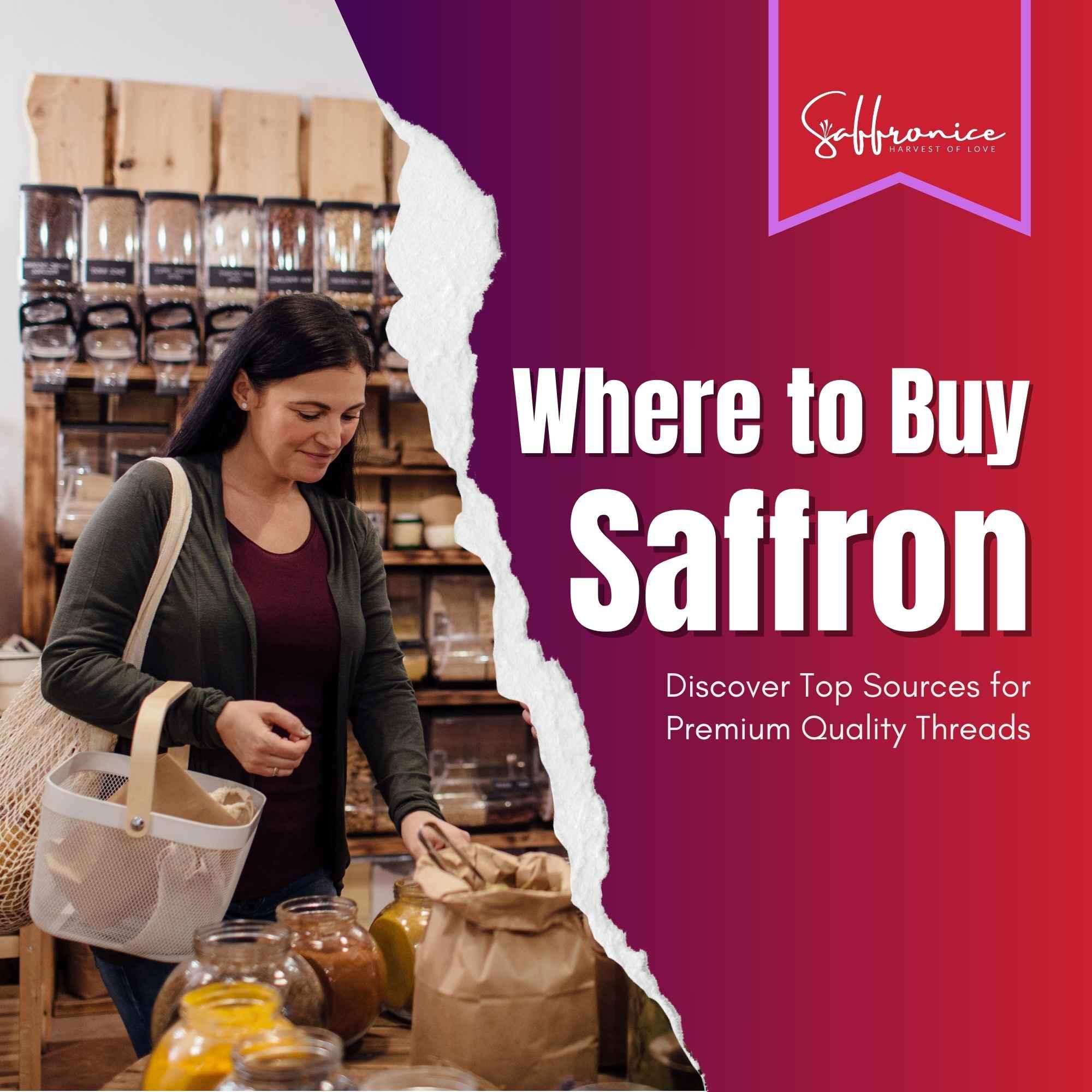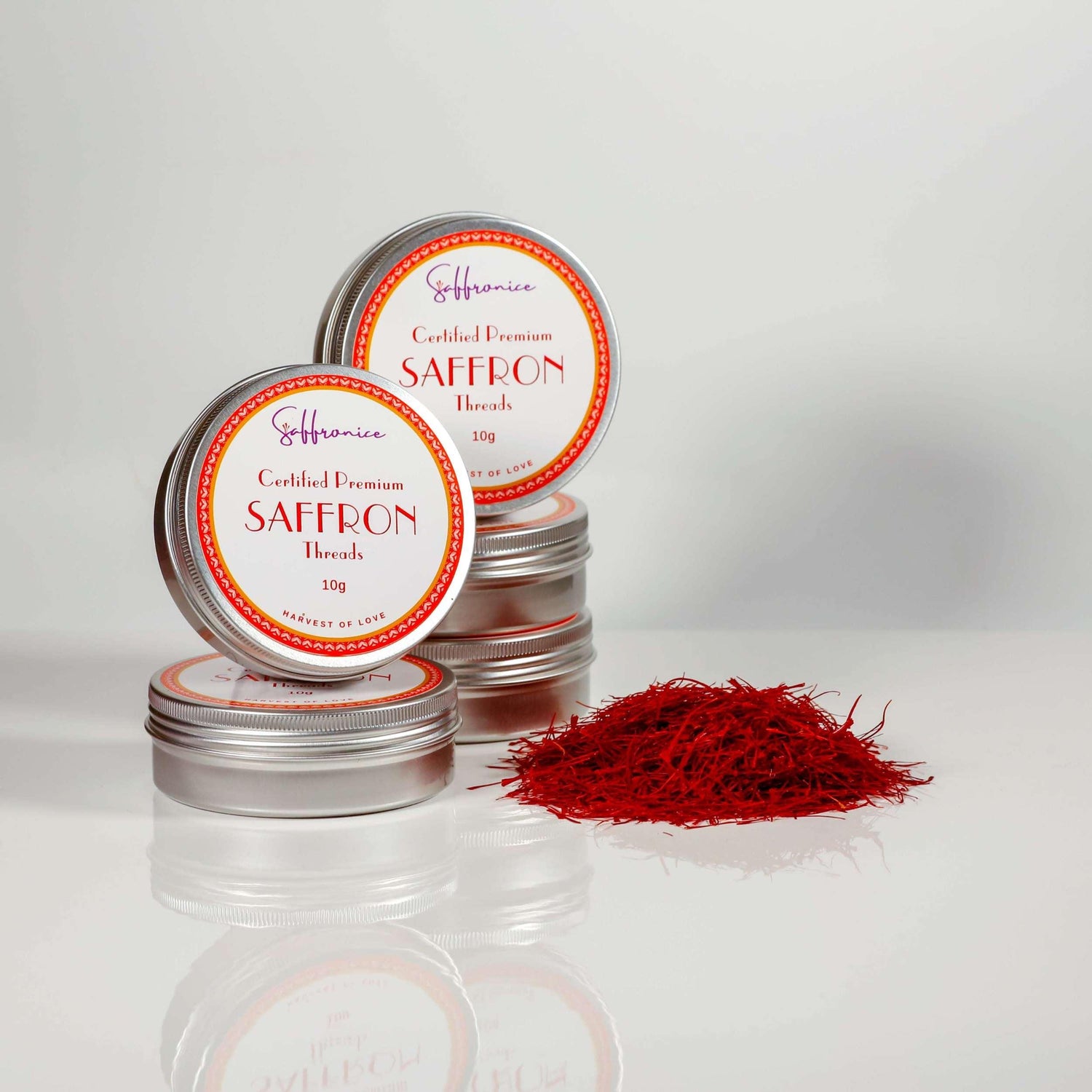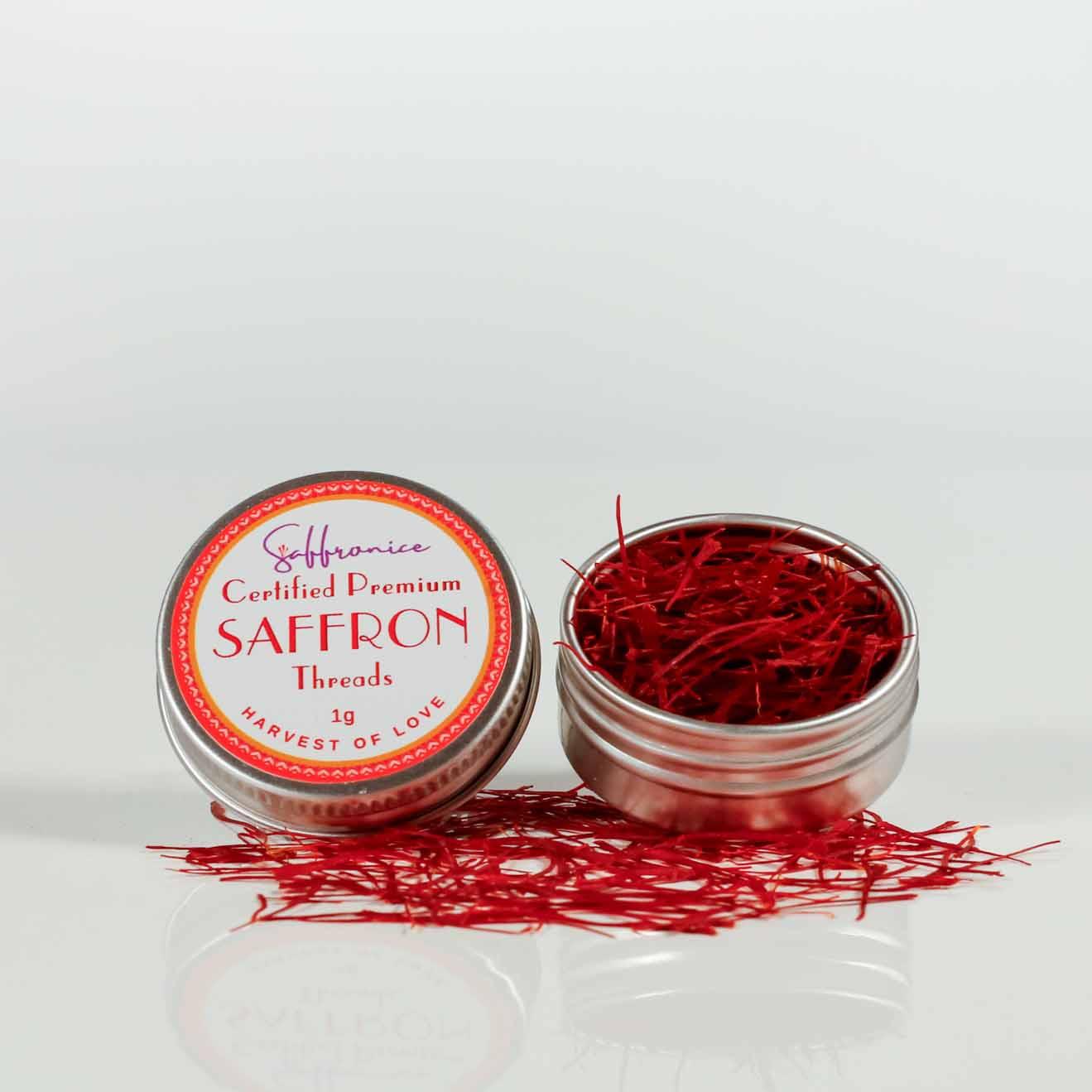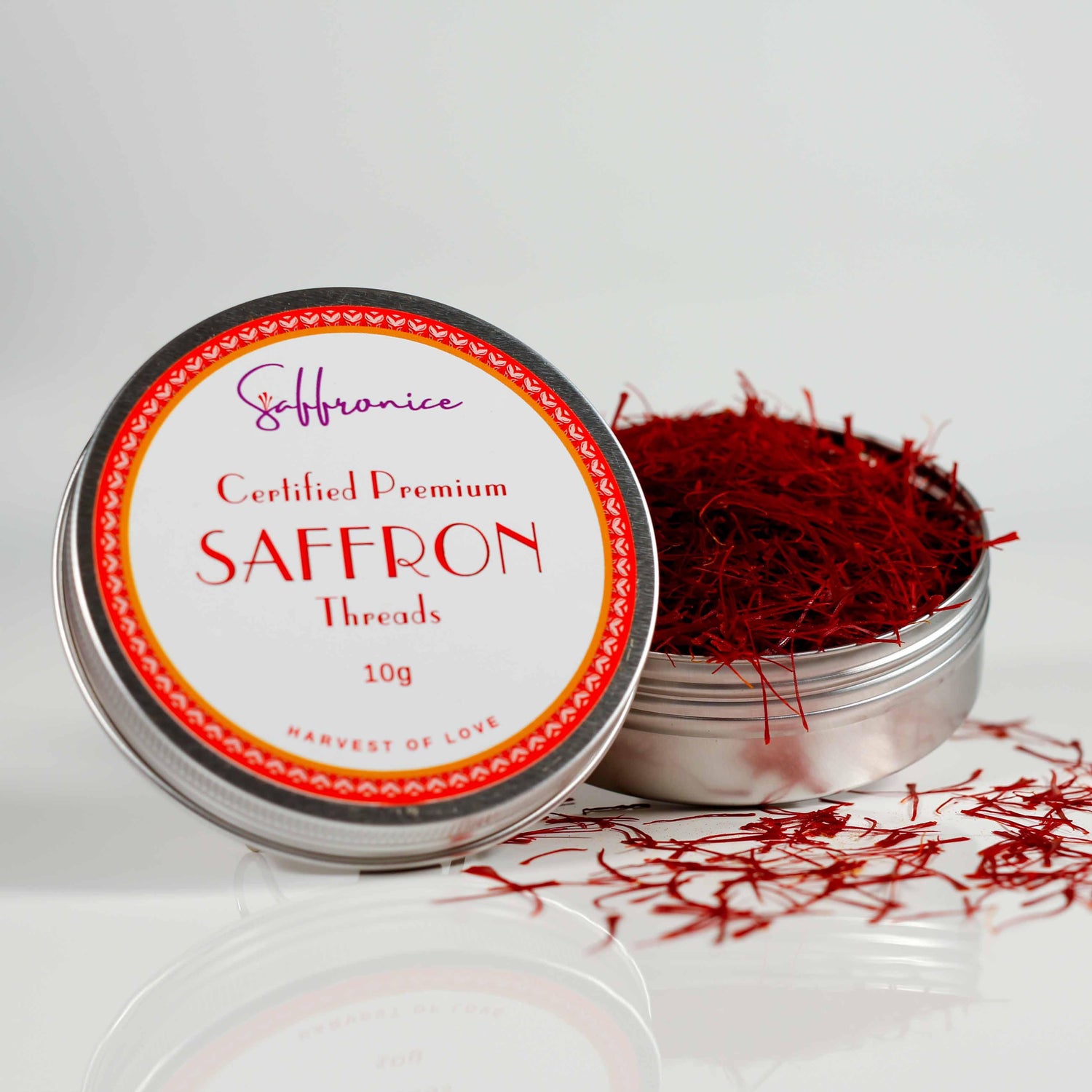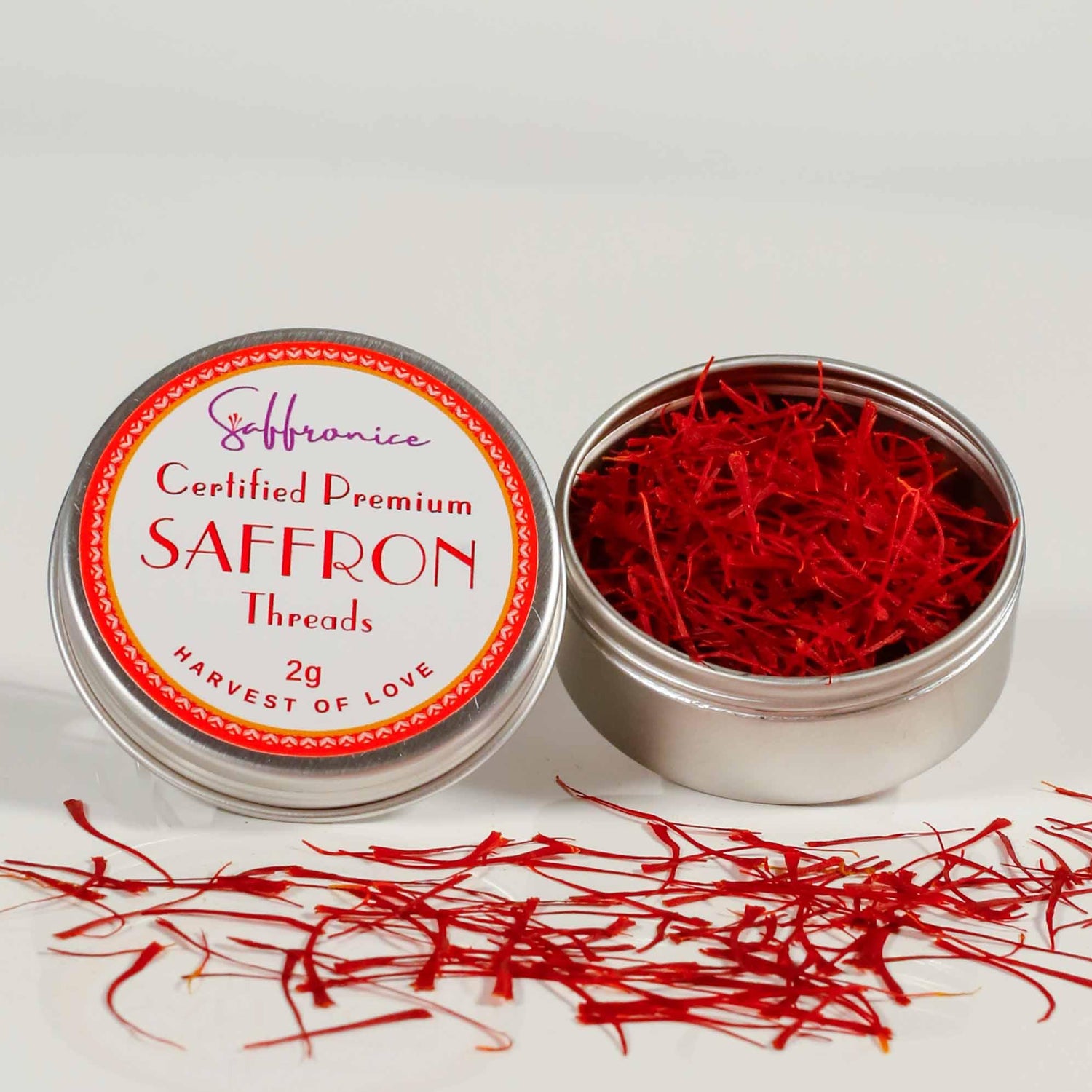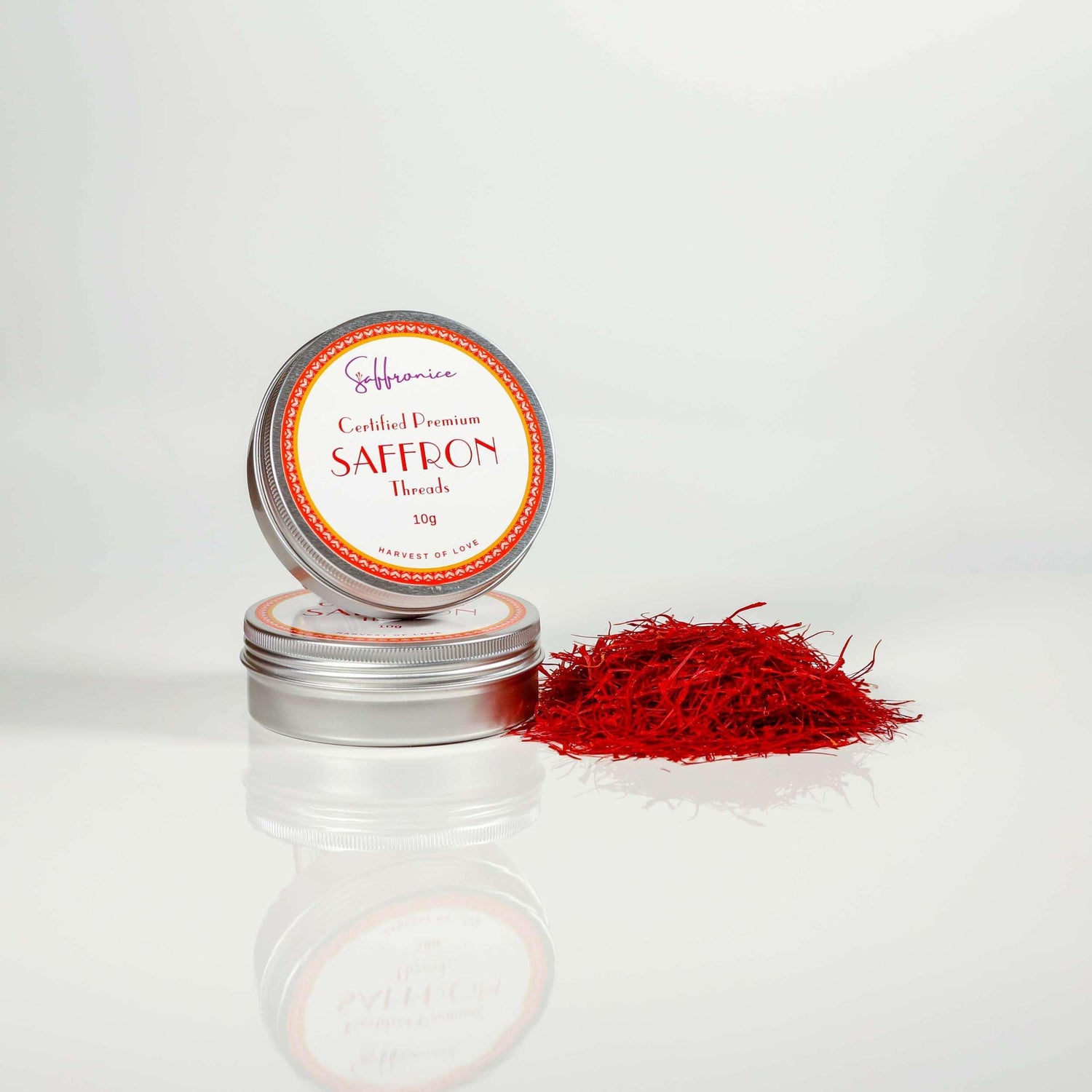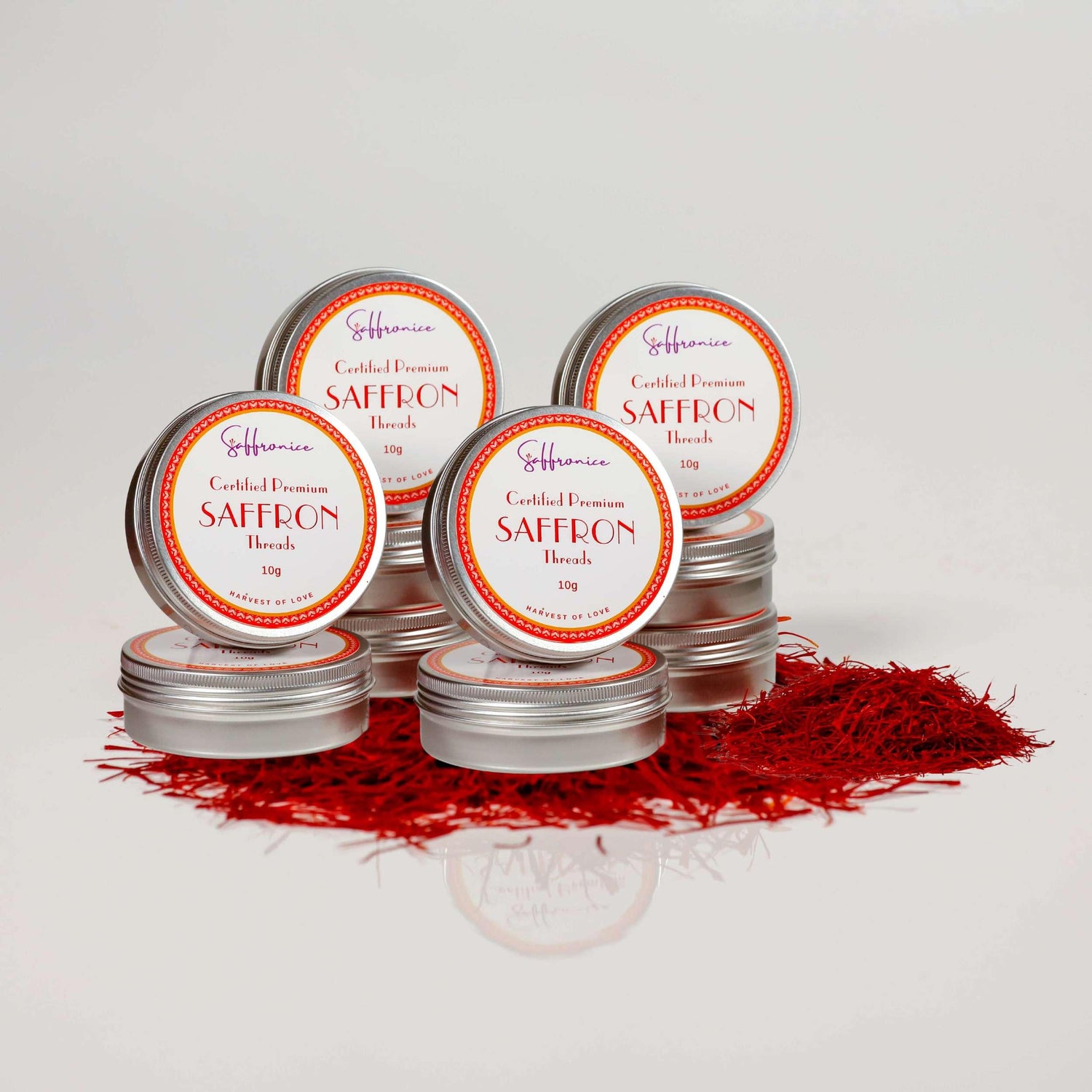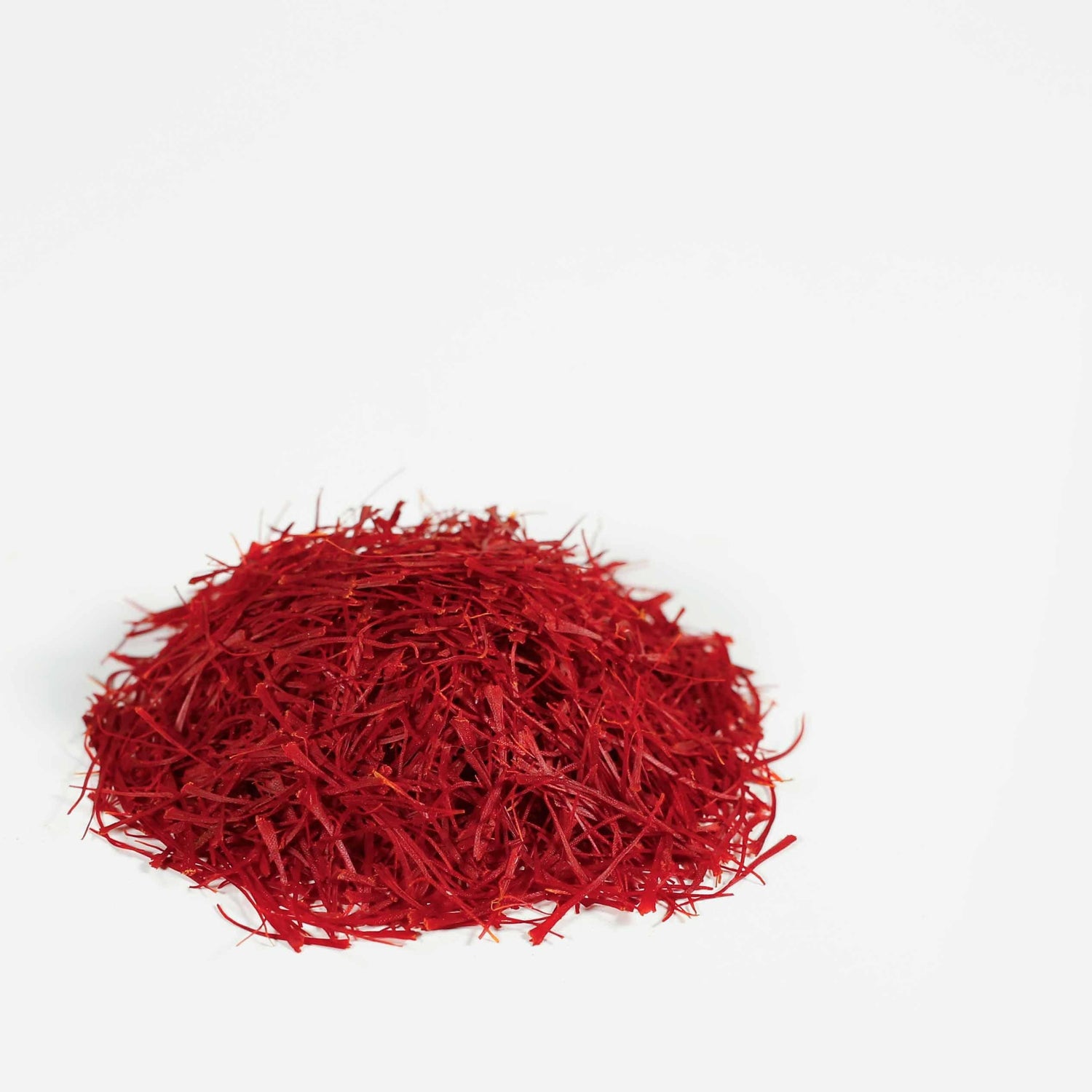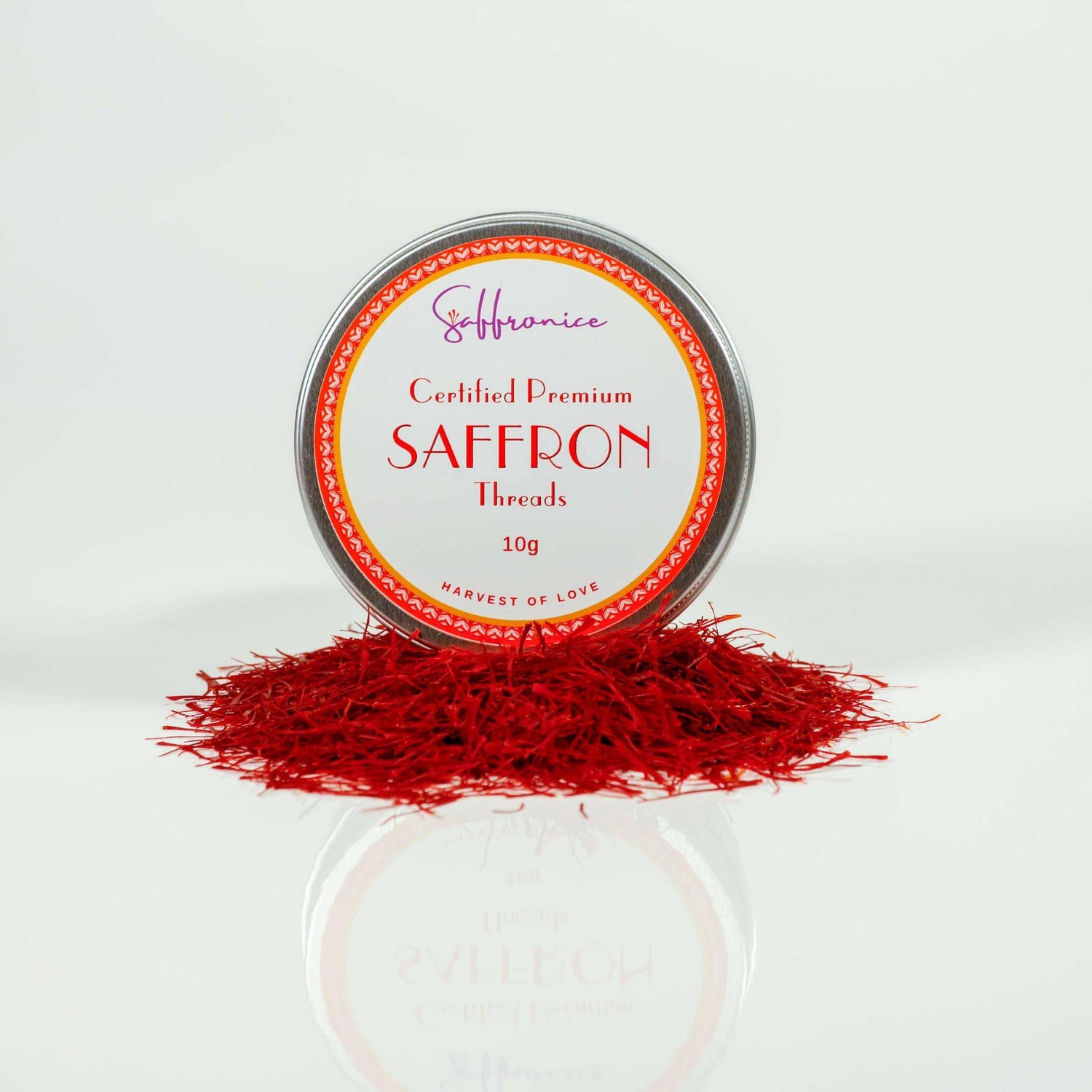Ah, Saffron! The golden threads have been tantalising taste buds and adding a touch of luxury to our dishes for centuries. Known as 'red gold', this vibrant spice is derived from the saffron crocus flower and is especially cherished for its unique flavour and aroma. But have you ever wondered "where to buy the highest quality saffron "? How do you tell if it's genuine? If so, you're in for a treat!
Key Takeaways
- Explore sources for top-quality Pure Saffron Threads, from Middle Eastern and European retailers to specialty spice shops and local markets.
- Understand different grades of Saffron to get the best flavour & aroma. Use it in dishes ranging from Persian Rice to Swedish cakes.
- Store properly & know how to identify genuine Saffron - look out for its bright red colour, sweet taste & strong smell!

Exploring Saffron Sources
Saffron threads of the highest quality often hail from:
- The Middle East, particularly Iran, which is recognised as the world's largest producer of this golden spice (97% of all Saffron is Produced in Iran)
- Spain's Castilla-La Mancha region
- Greece
- Afghanistan
These regions are known for their highest-quality saffron yield, surpassing others with high-quality Saffron.
Online Retailers
When purchasing Saffron from online retailers, it is crucial to evaluate several key factors to ensure you get a high-quality product. Firstly, look for a money-back guarantee, which indicates the retailer's confidence in their product and provides you with security. The packaging of Saffron is also paramount; avoid buying Saffron packed in plastic or transparent containers, as exposure to light can significantly degrade its quality. Instead, choose Saffron packaged in dark, airtight containers to preserve its flavour and aroma. Lastly, consider independent customer reviews, as they offer unbiased insights into the product's quality and the retailer's reliability. These reviews can be a valuable guide in making an informed decision and ensuring you receive the best quality saffron for your culinary or medicinal needs.
Speciality Spice Shops
Speciality spice shops elevate the experience of shopping for Saffron. At these locations, you can expect:
- Superior quality Crocus sativus ensures the highest standard of Saffron.
- Informed Guidance: Gain insights from experts who are well-versed in Saffron.
- Authentic Sourcing: Saffron is obtained from reputable suppliers in countries known for their exceptional quality Crocus sativus flowers.
These shops provide valuable advice on choosing the finest Saffron threads or powder saffron, helping you identify the best in terms of colour, taste, aroma, and price. They may offer this guidance in-store through knowledgeable staff or via online resources.
You can touch, smell, and even taste the Saffron when visiting specialty shops in the Middle East. However, exercise caution with vendors who may rush or aggressively upsell their products. It's essential to be well-informed before making a purchase. Additionally, be mindful of the customs and regulations of your country. Some authorities may restrict bringing Saffron back home, so confirming you can legally re-enter your country with the product is essential.

Local Markets
Local markets provide a unique shopping experience where you can:
- Engage directly with the producers and learn about the product's growth process
- Support local farmers and the economy
- Purchase fresh and top-notch quality saffron
When selecting Saffron at local markets, look for vibrant colours, hand-harvested stigmas picked before sunrise, and a robust and potent smell. The grade of Saffron you choose should be based on your specific needs. Higher grades cost more but pack a bigger punch in terms of flavour.
Understanding Saffron Grades
Navigating the saffron world involves understanding this esteemed spice's distinct grades. The grading is primarily based on the physical aspects of the saffron stigmas, particularly their size and uniformity. Super Negin is at the pinnacle of saffron grades, characterised by its long, uniformly thick, deep red stigmas. This grade is exceptional because it contains only the stigma part of the saffron thread, with no style attached, ensuring the utmost purity and quality.

Further down the grading spectrum are Negin, Sargol, and Dasteh (or Bunch) saffron. Each grade has its unique attributes and is suitable for different uses. Negin saffron is notable for its long, vibrant threads, ideal for high-end culinary applications. Sargol, on the other hand, comprises only the tips of the stigmas, resulting in a profoundly intense red colour and robust flavour. Dasteh Bunch saffron, being more budget-friendly, includes both the red stigmas and the yellow styles, offering a more balanced flavour and colour intensity but with a lesser concentration of the valuable red stigmas.
Super Negin: A Mark of Excellence
Super Negin saffron represents the highest echelon in saffron grading. Its strikingly long, flat, and uniformly red threads define this grade, making it a prized ingredient among top chefs worldwide. The meticulous selection and drying of these threads ensures that Super Negin saffron maintains its unparalleled purity and quality. Recognisable by its distinctive sweet aroma and the absence of the style, Super Negin saffron is a symbol of luxury and quality in the culinary world.

Negin, Sargol, and Dasteh/ Bunch: Varieties for Every Need
Negin, Sargol, and Dasteh Bunch each offer unique qualities. Negin saffron, with its lengthy threads and vibrant colour, is a favourite for gourmet cooking. Sargol, known for its intense colour and flavour of short stigma tips, is a premium choice that packs a punch in aroma and taste. Dasteh Bunch saffron, which is more economical, combines red stigmas and yellow styles, which are suitable for applications with a milder saffron presence, such as in specific industrial uses. Each grade caters to different preferences and requirements, making the world of saffron diverse and fascinating.
Saffron in Cuisine
With its versatile nature, Saffron has been incorporated into many culinary creations. From rice dishes to desserts and beverages, this golden spice adds a unique flavour that is both delightful and memorable.
Many cultures consider saffron-infused rice dishes as a staple. Whether it's the vibrant yellow saffron Rice, creamy Italian Risotto Alla Milanese, or the famous Spanish paella, these dishes showcase Saffron's rich flavours. Regarding beverages, saffron milk and tea, known for their calming properties and golden colour, are popular.
Besides rice dishes and beverages, Saffron is incorporated into various other dishes. Some examples include:
- Saffron Chicken Tagine
- Homemade Tagliatelle with Saffron Zucchini
- Swedish Saffron Cake
- Lemon Saffron Cheesecake Cups
- Saffron and Vanilla Panna Cotta
This versatile spice adds a luxurious and elegant touch to any dish.

Rice Dishes
Rice dishes infused with Saffron are a gastronomic delight. Whether it's the vibrant yellow saffron Rice, creamy Italian Risotto Alla Milanese, or the famous Spanish paella, these dishes showcase Saffron's rich flavours. The unique flavour profiles of each dish indeed highlight the versatility of Saffron and its ability to transform a simple rice dish into a culinary masterpiece.
One such dish is the Persian saffron rice, also known as Rice with a crispy bottom called Tahdig. This dish brings out the full flavour of Saffron, with a crisp, flavourful bottom layer and a fluffy, aromatic top layer of Rice. The key to achieving this is to grind a pinch of saffron threads into a fine powder and add it to your recipes. Alternatively, you can soak the threads in lukewarm water or broth and incorporate this infusion into your cooking for a rich and aromatic flavour.

Saffron Milk and Tea
Saffron milk and tea showcase the unique flavour and aroma of the spice. In Indian culture, saffron milk is celebrated for its health benefits, while saffron tea offers a glimpse into the history and culture of the spice. These drinks delight the senses with their floral, honey-like, musky, and earthy taste.
To prepare saffron milk, saffron strands are steeped in milk and sweetened with sugar. Dried fruits and nuts are often added for added flavour and crunch.
Saffron tea, on the other hand, is prepared by:
- Adding a pinch of Saffron to lukewarm water
- Optionally adding a slice of ginger for extra flavour
- Letting it sit for 5 minutes
- Straining it
- It's then ready to drink.

Other Culinary Creations
Aside from rice dishes and beverages, Saffron is also used in other culinary creations. Some examples include:
- Roasted Vegetable and Quinoa Salad with Saffron Dukkah Mix
- Shrimp with Saffron Rice and Fennel Salad
-
Chicken Curry with Madras Saffron Curry Mix
Italian Pizza Herbs and Spice Mix with Saffron
Saffron, derived from the saffron flower, adds a touch of luxury and elegance to any dish.
The unique flavour of Saffron, with its floral and earthy undertones, elevates the taste of any dish it adds. This versatility is one reason why Saffron is a favourite ingredient in:
- Persian cuisine
- Indian cuisine
- Spanish cuisine
- Italian cuisine
- Moroccan cuisine
Each of these cuisines has traditional dishes that showcase the unique flavours of this golden spice.

Health Benefits of Saffron
Saffron, cherished for its culinary attributes, is also a powerhouse of health benefits. This illustrious spice is laden with bioactive compounds such as crocin, crocetin, and safranal, making it a formidable antioxidant. These compounds are instrumental in neutralising harmful free radicals in the body, thus contributing to overall health and well-being.
The mental health benefits of Saffron are particularly noteworthy. Research indicates that Saffron may play a positive role in enhancing mood and alleviating symptoms of depression. This suggests its potential as a natural aid for emotional well-being.
Beyond its mental health applications, Saffron has been associated with other significant health benefits. It may aid in heart health by positively influencing blood cholesterol levels and blood pressure. Additionally, Saffron is known for its anti-inflammatory properties, which can be beneficial in reducing discomfort associated with conditions like arthritis. Its potential to aid digestive health, including soothing upset stomachs and reducing inflammation in the gastrointestinal tract, is also recognised.
Furthermore, Saffron's role in vision health has garnered interest. Certain compounds in Saffron may help protect against age-related macular degeneration and improve vision in adults.
In summary, Saffron transcends its culinary uses, emerging as a multifaceted contributor to health. From enhancing mental well-being to supporting heart, digestive, and vision health, Saffron is a spice that nourishes the body and mind.

Tips for Storing and Using Saffron
To preserve the quality and enhance the longevity of your Saffron, adhere to the following storage recommendations:
- Store Saffron in a sealed, light-proof metal container. This protects it from light and air exposure, maintaining its quality.
- Avoid using plastic containers or packaging for storage, as they can transfer odours and allow UV light to degrade the Saffron.
- The best practice is to keep Saffron in the refrigerator. Only take out what you need and promptly return the rest to the fridge door area when using.
- Never freeze Saffron, as extremely low and high temperatures can degrade its bioactive components.
- Keep Saffron away from items with solid aromas to prevent it from absorbing unintended scents.
By following these storage guidelines, you can ensure that your Saffron retains its distinctive flavour and aroma for an extended period.
Practical Usage of Saffron in Cooking and Medicinal Applications
To maximise the benefits of Saffron in your cooking and health routines:
- Preparing Saffron using lukewarm or water at room temperature is recommended for culinary purposes. This helps in releasing its flavours without diminishing their quality.
- Opt for crushed ice or cold water when using Saffron for medicinal purposes. This method preserves the delicate bio-active compounds of Saffron, ensuring you receive its full health benefits.
These usage guidelines will help you extract your Saffron's maximum flavour and medicinal value.
Using Saffron in Cooking
Saffron, known for its unique and rich flavour, can significantly enhance your culinary creations. Here are some tips to make the most out of this precious spice in your cooking:
- Measuring the Right Amount: The key to perfecting any dish with Saffron is to use the correct amount. This depends on your recipe and the desired intensity of flavour. Typically, a small amount, such as a pinch of Saffron threads, is sufficient for most recipes.
- Creating a Fine Powder: Grind the threads into a fine powder to fully unleash Saffron's flavour. This can be done using a mortar and pestle or a spice grinder. Powdered Saffron releases its flavour more readily, making it ideal for dishes where you want a more immediate and intense Saffron taste.
- Soaking Saffron Threads: Another effective technique is to soak Saffron threads in lukewarm water or milk for at least 10 minutes before using them in your recipe. This soaking process lets the Saffron release its distinct flavours and colours thoroughly. The resulting Saffron-infused liquid can then be added to your dishes, imparting a deep, aromatic flavour and a vibrant colour.
By following these tips, you can enhance your dishes with Saffron's exquisite flavour and aroma, turning ordinary recipes into extraordinary culinary experiences.

How to Identify Genuine Saffron
Due to its high value, it's crucial to distinguish genuine Saffron to ensure you're purchasing an authentic product. The following characteristics can identify Authentic Saffron:
- Colour: Genuine Saffron has a vibrant, deep red colour. The threads should be uniformly coloured without any colour fading or inconsistency.
- Taste: Authentic Saffron does not have a sweet taste; instead, it should have a slightly bitter and complex flavour. The absence of sweetness is a crucial indicator of genuine Saffron.
- Aroma: Genuine Saffron casts a solid and distinct aroma, which can be described as a mix of floral and earthy notes. The aroma should be pleasant and not overpowering.
- Thread Shape: True Saffron threads are trumpet-shaped and tend to bulge at one end, displaying a unique and recognisable morphology.
Water Test for Authenticity
A reliable method to test the authenticity of Saffron involves soaking the threads in water:
- Colour Change: When placed in water, genuine Saffron threads slowly release a golden-yellow hue, gradually colouring the water. This process can take up to an hour, reflecting the natural release of colour from authentic Saffron.
- Thread Color Retention: The saffron threads remain red, even after being soaked in water. This persistence of colour is a hallmark of genuine Saffron.
- Aroma: The soaking process also releases the characteristic floral scent of Saffron, further confirming its authenticity.
These tests and observations are essential in confirming the authenticity of Saffron, helping you ensure that you are getting the value and quality of this esteemed spice.

Summary
From the Middle Eastern fields to your dinner table, Saffron is a spice worth its weight in gold. Whether it's enhancing the flavour of your dishes, providing multiple health benefits, or its fascinating history and culture, Saffron truly stands out. We hope this guide has illuminated the path to identifying and using this precious spice and that it inspires you to embark on your saffron culinary journey.
Frequently Asked Questions
Can you buy Saffron in the supermarket?
Saffron is available for purchase in many large grocery stores and specialty markets. However, it's essential to be aware that the quality of Saffron found in these outlets may often be lower than that of specialty or high-end suppliers.
Is McCormick saffron real saffron?
Yes, McCormick Saffron is indeed genuine Saffron. Known for sourcing its Saffron from Spain, a region recognised for producing high-quality Saffron, McCormick ensures the authenticity of its product. Each bottle contains over 250 hand-picked strands, reflecting the labour-intensive process of harvesting Saffron. As the world's most expensive spice, Saffron emanates from the stigma of the crocus flower. McCormick's adherence to these standards guarantees genuine Saffron when you purchase their product.
How much does actual saffron cost?
Genuine Saffron can cost anywhere from $10 to $20 per gram, making it the world's most expensive spice. Its unique flavour and properties as a natural food dye make it worth the investment.
Where do you get the best Saffron?
Look no further for the highest quality saffron than Super Negin Saffron, grown in Iran. This labour-intensive process yields only the finest threads from the crocus sativus flower.
What countries produce the best-quality Saffron?
Iran, Spain, Greece and Afghanistan are renowned for producing some of the best-quality Saffron.
Learn Other Saffron Basic Knowledge.


